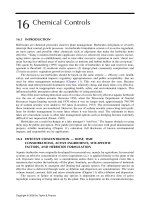Lecture management a pacific rim focus chapter 16 controlling the organisation
Bạn đang xem bản rút gọn của tài liệu. Xem và tải ngay bản đầy đủ của tài liệu tại đây (408.95 KB, 20 trang )
CHAPTER 16
CONTROLLING THE
ORGANISATION
© 2003 McGraw-Hill Australia Pty Ltd. PowerPoint
1
Lecture outline
•
•
•
•
•
Control as a management function
The control process
Types of control
Managerial approaches to control
Assessing control systems
© 2003 McGraw-Hill Australia Pty Ltd. PowerPoint
2
Control as a management
function
Controlling:
Process of regulating organisational activities so that
actual performance conforms to expected
organisational standards and goals.
© 2003 McGraw-Hill Australia Pty Ltd. PowerPoint
3
Control as a management
function
Role of controls:
• Coping with uncertainty
• Detecting irregularities
• Identifying opportunities
• Handling complex situations
© 2003 McGraw-Hill Australia Pty Ltd. PowerPoint
4
Control as a management
function
Levels of control
Strategic
Strategic planning
planning
Strategic
Strategic control
control
Tactical
Tactical planning
planning
Tactical
Tactical control
control
Operational
Operational planning
planning
Operational
Operational control
control
© 2003 McGraw-Hill Australia Pty Ltd. PowerPoint
5
The control process
Steps in the control process:
Determine
Determineareas
areasto
tocontrol
control
Establish
Establishstandards
standards
Control
Control
process
process
steps
steps
Measure
Measureperformance
performance
Compare
Compareperformance
performance
Recognise
Recognisepositive
positive
performance
performance
Take
Takecorrective
correctiveaction
action
Adjust
Adjuststandards
standards
© 2003 McGraw-Hill Australia Pty Ltd. PowerPoint
6
The control process
Deciding what to control:
High
Highdependence
dependenceon
onthe
theresource
resource
Determining
Determining
strategic
strategic
control
control
points
points
Chance
Chancethat
thatexpected
expectedresource
resourceflow
flowwill
will
be
unacceptable
be unacceptable
Control-process
Control-processfeasibility
feasibility
Cost
Costacceptability
acceptability
Alternatives
Alternativesto
tocontrol
control
••Change
Changedependence
dependencerelationships
relationships
••Change
Changenature
natureofofdependence
dependencerelationships
relationships
© 2003 McGraw-Hill Australia Pty Ltd. PowerPoint
7
Types of control
Types of control:
• Major types by timing
• Multiple controls
• Cybernetic & non-cybernetic controls
© 2003 McGraw-Hill Australia Pty Ltd. PowerPoint
8
Types of control
Types by timing:
Input
Input
Feed-forward
Feed-forward
control.
control.
Anticipating
Anticipating
problems
problems
Transformation
Transformation
processes
processes
Concurrent
Concurrent
control.
control.
Attending
Attendingtoto
problems
problemsas
as
they
theyoccur
occur
Outputs
Outputs
Feedback
Feedback
control.
control.
Correcting
Correcting
problems
problemsafter
after
product/
service
product/ service
isisproduced
produced
© 2003 McGraw-Hill Australia Pty Ltd. PowerPoint
9
Types of control
• Multiple controls
Systems using two or more of the feedforward, concurrent
and feedback control processes and involving several
strategic control points.
• Cybernetic
Self-regulating control system which, once operating, can
automatically monitor the situation and take corrective action
when necessary.
• Non-cybernetic
Control system relying on human discretion as a basic part of
its process.
© 2003 McGraw-Hill Australia Pty Ltd. PowerPoint
10
Managerial approaches
•
•
•
•
Bureaucratic control
Clan control
Market control
Control & innovation
© 2003 McGraw-Hill Australia Pty Ltd. PowerPoint
11
Managerial approaches
Bureaucratic control:
Managerial approach relying on regulation through
rules, policies, supervision, budgets, schedules,
reward systems and other administrative
mechanisms aimed at ensuring employees exhibit
appropriate behaviours and meet performance
standards.
© 2003 McGraw-Hill Australia Pty Ltd. PowerPoint
12
Managerial approaches
Clan control:
Managerial approach relying on values, beliefs,
traditions, corporate culture, shared norms and
informal relationships to regulate employee
behaviours and facilitate reaching of organisational
goals.
© 2003 McGraw-Hill Australia Pty Ltd. PowerPoint
13
Managerial approaches
Market control:
Managerial approach relying on market mechanisms
to regulate prices for certain clearly specified goods
and services needed by an organisation.
© 2003 McGraw-Hill Australia Pty Ltd. PowerPoint
14
Managerial approaches
Control & innovation:
Four levers for strategic control/innovation—
• Belief systems
Mission, core values
• Boundary systems
Risk avoidance, policies, rules, procedures
• Performance management systems
Critical goals, evaluation & feedback
• Interactive monitoring systems
Opportunity focus, networking, continuous search & learning
© 2003 McGraw-Hill Australia Pty Ltd. PowerPoint
15
Assessing control systems
Operating
Operatingdelays
delays
‘actions
‘actionsneeded
neededby
by
feedforward
feedforward&&
concurrent
concurrentcontrols’
controls’
Behavioural
Behavioural
displacement
displacement
‘behaviour
‘behaviour
encouraged
encouragedinconsistent
inconsistent
with
withorganisational
organisational
goals’
goals’
Negative
Negativeattitudes
attitudes
Induced
Inducedby
byexcessive
excessive&&
poorly
poorlydesigned
designedcontrols
controls
Game
Gameplaying
playing
‘managers
‘managersimprove
improve
their
theirstanding
standing…by
…by
manipulating
manipulatingresource
resource
usage
usage&/or
&/ordata’
data’
© 2003 McGraw-Hill Australia Pty Ltd. PowerPoint
16
Assessing control systems
Over-control versus under-control:
Over-control
Over-control
‘limiting
‘limitingindividual
individual job
jobautonomy
autonomy
to
tothe
thepoint
point where
whereititseriously
seriouslyinhibits
inhibits
job
jobperformance’.
performance’.
Under-control
Under-control
‘...giving
‘...givingautonomy
autonomyto
toan
anemployee
employeeto
to
where
wherethe
theorganisation
organisationloses
loses the
theability
ability
to
todirect
directefforts’.
efforts’.
© 2003 McGraw-Hill Australia Pty Ltd. PowerPoint
17
Assessing control systems
Characteristics
control systems
• Future oriented of effective
• Timely
•
•
•
•
Multi-dimensional
Cost-effective
Accurate
Realistic
• Monitorable
• Acceptable to organisational
members
• Flexible
© 2003 McGraw-Hill Australia Pty Ltd. PowerPoint
18
Lecture summary
• Control as a management function
–
–
–
Significance of the control process
Role of controls
levels of control
• The control process
–
–
Steps in the process
Strategic control points
• Types of control
–
Types by timing, multiple, cybernetic, non-cybernetic
© 2003 McGraw-Hill Australia Pty Ltd. PowerPoint
19
Lecture summary
• Managerial approaches to control
–
–
Bureaucratic, clan, market
Control & innovation
• Assessing control systems
–
–
–
Dysfunctions
Over-control/under-control
Characteristics of effective control systems
© 2003 McGraw-Hill Australia Pty Ltd. PowerPoint
20









